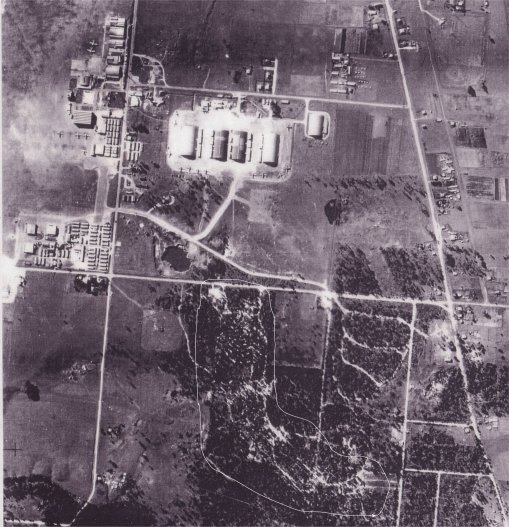
photograph. There was a large radio mast located immediately to the
west of Camp Muckley. It can be seen in the square “mown” area. Source OzatWar
The construction of Camp Muckley was the second’ job done by the U.S. Army. in this Brisbane area, practically simultaneously with the first section of Camp Columbia.
Designed as a 1, 000 man staging camp and included mess halls,14 man-barracks, bathhouses, latrines, and water-borne sewerage to septic tanks. Works performed by private contract. Total cost approximately 30,090 pounds. Owing to the conditions then existing in this area, both Camp Columbia and Camp Muckley were originally designed on a dispersal basis, buildings being constructed within wooded areas and concealed as far as possible.
The men of the 39th Troop Carrier Squadron of the 317th Troop Carrier Group of the 5th Air Force initially lived at Camp Muckley. The enlisted men lived in open barracks while the officers had partitioned quarters. They later moved to new barracks at Archerfield Airfield. The USAAF 49th Fighter Group arrived in Brisbane in October 1942 as part of Fifth Air Force, they set up a camp here. The unit received Curtiss P-40 Warhawks and, after training for a short time, provided air defense for the Northern Territory, before moving to New Guinea. In 1945 they became part of the occupation force of Japan.
The Camp was named after Second Lieutenant Dwight S. Muckley, Jr. who was killed in a bomber crash in the Archerfield area on 5 June 1942.
By the time the squadron arrived in Brisbane the Army had already bulldozed a road – known as the munition road – from the Archerfield Road to Wacol Station, for which they also had to build a bridge over Bullockhead Creek.
After the war the Queensland Housing Commission (QHC) administered these buildings as temporary accommodation for displaced and or destitute people. In 1953 the QHC was developing the areas close to and directly to the east of Camp Muckley.
